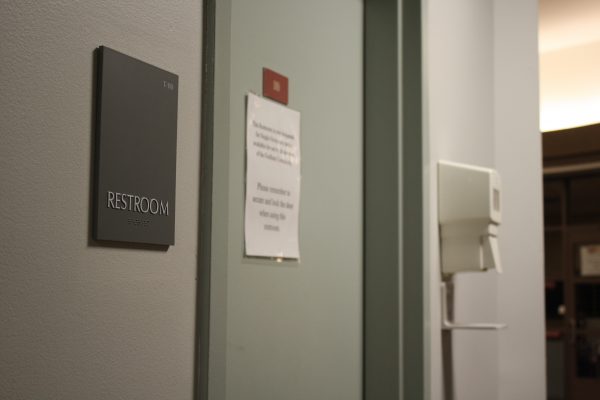Students Advocate for Gender Neutral Signage
Signage of bathroom located near the lobby of McMahon Hall was changed to just say “Restroom” in 2017. (ASEAH KHAN/THE OBSERVER)
January 26, 2017
Student advocacy for gender-neutral bathrooms on campus continues, as Peyton Berry, Fordham College at Lincoln Center (FCLC) ’18, and other students meet with university administrators about getting official signage for unisex restrooms on campus. Temporary signage was posted outside the single-occupancy bathrooms in the McMahon lobby, but some students still remain frustrated with the lack of progress.
Keith Eldredge, dean of students at Fordham Lincoln Center, said that these signs are only there until placards simply saying “Restroom” can be installed. “My expectation was that [the new signs for the McMahon bathrooms] were both going to say ‘Restroom,’ like the third floor of Lowenstein, but something was miscommunicated during the installation,” Eldredge said.
The temporary signs are printed on plain printer paper. They state that the single-stalled bathrooms are “now designated for Single-Occupancy and is available for use by all members of the Fordham community,” and hold no reference to sex or gender.
The debate over what labeling to use on unisex bathrooms on campus has been going on for some time now. Berry, the student currently spearheading the newest iteration of the push for full signage, says that they’ve been involved since their freshman year (2014 — 2015), and that from their understanding, it really started with the efforts of recent Fordham graduate Chris Hennessy, FCLC ’16.
Eldredge said the first non-gendered signs went up in the fall of 2015, after talks with students concerned with the lack of restrooms available to transgender and gender-nonconforming students. After meeting with them and discussing what language to use, he said, “We decided as a university that the best thing to put on the signage was simply ‘Restroom.’”
He continued, that he was “not going to say that [the students] necessarily supported it or agreed with it at the time, but my sense of it at the time was they said ‘Okay, at least it’s a step in the right direction.’ And so the signage went up.”
While Eldredge said that the plain “Restroom” signs are what “the standard is from our perspective,” he also mentioned that new students have since come forward to disagree, and are working with Dorothy Wenzel, Ph.D., director of the Office of Student Involvement, as well as himself to continue pushing for explicit labeling of these restrooms as gender-neutral.
“I’m still open to continuing that conversation: is what we have sufficient, is it meeting all the needs of the students, hearing from some students that it’s not, and want[ing] to continue that conversation,” Eldredge said. “But I [also] think I’m waiting for sort of the next set of information to come back, and to [have students] let us know exactly what they’re looking for.”
Berry, however, disagrees. They say that people involved, including members of the Rainbow Alliance, Fordham Lincoln Center’s LGBTQ+ club, and Hennessy have done just that, but it still feels like their efforts have not been enough.
“It’s really frustrating,” Berry said. “We’ve done surveys, we’ve done petitions, we’ve done face-to-face meetings, I’ve had written statements from non-binary students, and nothing, apparently, is enough to sway the minds we need to sway. ”
The newest signs have caused Berry further frustration.
“The reason it was offensive to me was because we have talked endlessly, every single person who has been involved with this, about the language, specifying that it says ‘for all genders,’ and I, as a gender nonconforming person, do not feel as though the university accepts or approves of my identity,” Berry said.
“I’m disheartened,” they continued. “That sign really actually made me lose a lot of hope, and made me kind of want to not fight for it anymore, because it just seems like it doesn’t matter what I do.”
Eldredge said the laminated McMahon signs are just a temporary measure, and that they are only there to remind students that, unlike with other public bathrooms on campus, they need to lock the door used to enter the restroom.
“We wanted to say, ‘Hey, this is designed now to be a single-use bathroom, but if you’re not used to that, you might want to lock the door,’” Eldredge said.
He reiterated that although students would ultimately have to take things up with Facilities, he remains “happy to continue to work with folks” on this issue.












